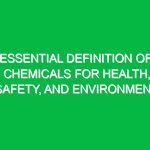Introduction
In the realm of Health, Safety, and Environment (HSE), understanding the definition of confined space is critical. Confined spaces pose unique challenges and risks that can lead to severe injuries or fatalities if not properly managed. A confined space is defined as an area that is not designed for continuous human occupancy and has limited means of entry or exit. This definition is crucial as it sets the stage for identifying potential hazards, implementing safety measures, and ensuring compliance with regulatory standards.
The relevance of confined spaces in industries such as construction, manufacturing, and waste management cannot be overstated. Workers often find themselves in these spaces, whether they are cleaning tanks, inspecting pipelines, or conducting maintenance in silos. In this guide, we will delve deeper into the definition of confined space, explore associated safety risks, and discuss best practices to mitigate these risks effectively.
Understanding Confined Space
Definition of Confined Space
The definition of confined space under the HSE context refers to an area that meets the following criteria:
- It is large enough for a worker to enter and perform assigned work.
- It has limited or restricted means of entry or exit, making it difficult for workers to get in or out.
- It is not designed for continuous occupancy.
Common examples include tanks, vessels, silos, pits, and tunnels. The conditions in these spaces can vary significantly, posing various hazards that require careful consideration and preparation.
Key Characteristics of Confined Spaces
Understanding the characteristics of confined spaces is essential for workplace safety. Here are several defining features:
- Limited Access: Entry and exit points are often narrow, making evacuation in emergencies challenging.
- Atmospheric Hazards: Confined spaces may contain dangerous gases, vapors, or lack sufficient oxygen levels.
- Physical Hazards: These can include machinery, equipment, or other obstructions that could injure workers.
- Work Environment: The confined nature of the space may cause stress and fatigue, increasing the likelihood of accidents.
Safety Risks Associated with Confined Spaces
The safety risks associated with confined spaces are numerous and can often be life-threatening. Here are some of the most significant hazards:
1. Atmospheric Hazards
Atmospheric hazards are one of the most critical risks in confined spaces. These can include:
- Oxygen Deficiency: Levels below 19.5% can cause unconsciousness and death.
- Toxic Gases: Substances like hydrogen sulfide or carbon monoxide can be present, posing significant health risks.
- Flammable Atmospheres: High concentrations of flammable gases can lead to explosions.
2. Physical Hazards
Physical hazards in confined spaces can lead to serious injuries. Examples include:
- Engulfment: Workers can be engulfed by materials such as sand or grain.
- Mechanical Hazards: Moving machinery or equipment can cause severe injuries.
- Slips, Trips, and Falls: The confined nature of the space can increase the risk of falls.
3. Psychological Stress
Working in confined spaces can induce psychological stress. The fear of being trapped or the overwhelming environment can affect a worker’s mental state, leading to poor decision-making and increased accident rates.
Best Practices for Safety in Confined Spaces
To ensure worker safety in confined spaces, employers and workers must adhere to best practices that mitigate risks. Here are some key strategies:
1. Pre-Entry Planning
Before any work begins in a confined space, a thorough risk assessment should be conducted. This includes:
- Identifying potential hazards.
- Establishing emergency procedures.
- Ensuring that all workers are trained in confined space entry procedures.
2. Continuous Monitoring
Continuous monitoring of atmospheric conditions is crucial. This can be achieved through:
- Using gas detectors to check for oxygen levels and toxic gases.
- Regularly assessing for flammable vapors.
3. Proper Equipment
Utilizing the right equipment can significantly reduce risks. This includes:
- Personal protective equipment (PPE) like respirators and harnesses.
- Ventilation equipment to ensure adequate airflow.
4. Training and Communication
All personnel involved in confined space work should receive comprehensive training. This should cover:
- The definition of confined space and associated risks.
- Emergency procedures and equipment use.
- Effective communication protocols among team members.
Real-Life Examples and Case Studies
Real-life examples serve to highlight the importance of adhering to safety protocols in confined spaces. One notable incident occurred in 2010 when three workers in a water treatment facility died due to a lack of oxygen while working in a confined space. Investigations revealed that the employees had not been properly trained to recognize the dangers of the atmosphere within the tank. This tragedy emphasizes the critical need for effective training and robust safety measures.
Another example is a construction site where a worker fell into a confined space while attempting to retrieve tools. The absence of proper barriers and signage contributed to the accident. Following this incident, the company implemented additional safety protocols, including mandatory barriers and confined space signage, which significantly reduced the risk of similar accidents.
Regulations and Standards Governing Confined Spaces
Understanding the regulations surrounding confined spaces is essential for compliance and worker safety. In many countries, regulations dictate specific requirements for working in confined spaces. For instance:
- OSHA Standards (USA): The Occupational Safety and Health Administration has established regulations that require employers to develop a confined space program, including training, monitoring, and emergency planning.
- HSE Regulations (UK): The Health and Safety Executive mandates risk assessments and safety measures before entry into confined spaces.
These regulations often require regular training, documentation of safety measures, and adherence to specific procedures to ensure worker safety.
Conclusion
In conclusion, understanding the definition of confined space and its associated risks is vital for ensuring health and safety in various industries. Confined spaces present significant hazards that can lead to serious injuries or fatalities if not addressed properly. By adhering to best practices, implementing proper training, and complying with relevant regulations, organizations can create a safer working environment for their employees.
Promoting awareness of confined space hazards and safety measures is essential in fostering a culture of safety. Further thought and action are necessary to protect workers and mitigate risks associated with confined spaces. Recognizing the importance of these efforts not only safeguards employees but also enhances overall workplace safety and productivity.


